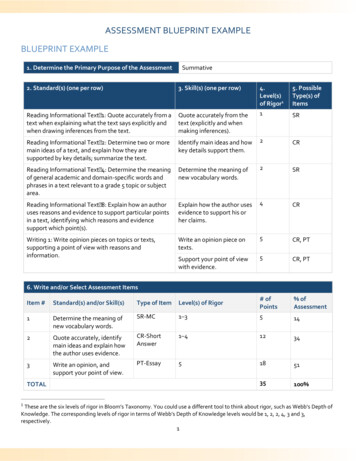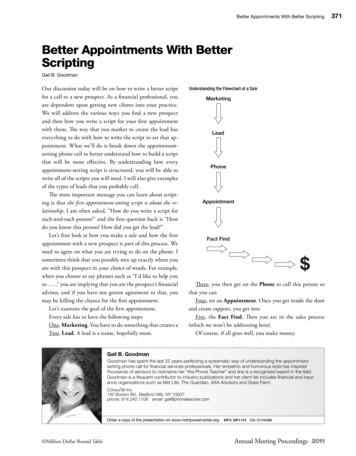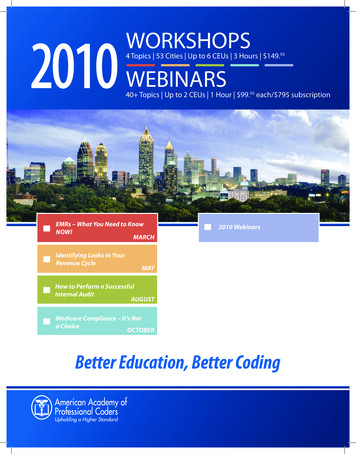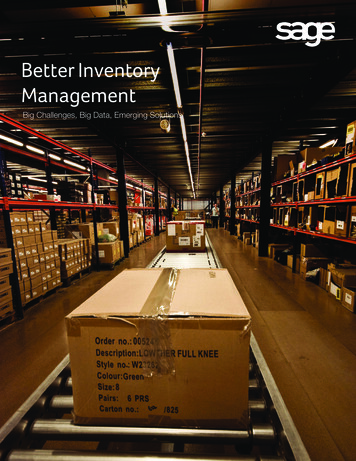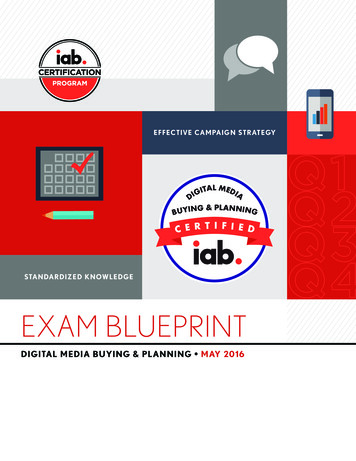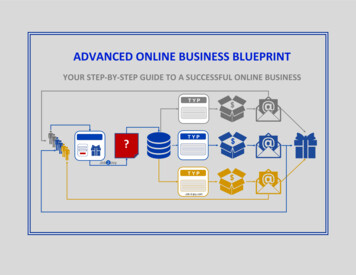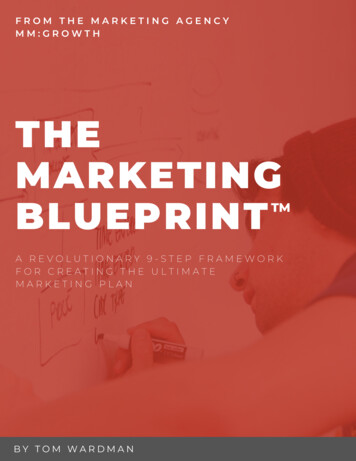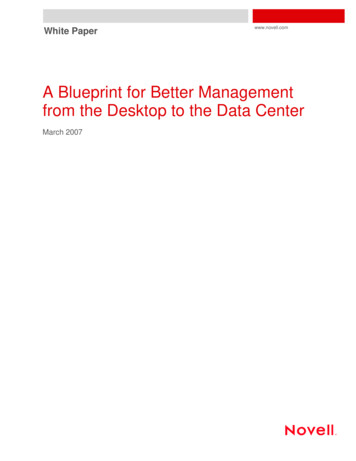
Transcription
White Paperwww.novell.comA Blueprint for Better Managementfrom the Desktop to the Data CenterMarch 2007
Table of ContentsExecutive Summary .3IT Infrastructure Library (ITIL) .5Blueprint for Desktop to Data Center Management .8A New Model of Computing .14Appendix—Open Standards and Open Source .16p. 2
Executive SummaryThere has been no greater change in IT management thinking in the last 30 years than the burgeoning focus onService-Oriented Architecture and Infrastructure. Simply put, instead of focusing solely on what IT work is done,organizations are now calling on CIOs to focus on how well IT delivers its full spectrum of services to support thebottom line.If an employee needs access to a service, they don’t care where the persistent data is stored, how the clientside, middleware or server software is instantiated, which servers it’s running on and what operating systems arerequired. They never did care. They only want the service, preferably every time they require access, with nounexpected interruptions or processing delays.We live in an on-demand world, and the technobabble IT department excuses and limitations are no longertolerated by today’s businesses. Service-Oriented Infrastructure creates new challenges for CIOs who alreadyare governed by legislation to ensure and attest to authorized access, control wasteful power consumption andbalance over-provisioning with redundancy for disaster tolerance. Now, IT organizations are consolidating theiroperating systems, servers and storage, and are implementing technologies like virtualization to overcome thestatic limitations of service deployment and continuity management that exist in the physical world.Delivering services to users requires successful implementation of all the management disciplines, but you mustgo further—these disciplines must interact seamlessly on behalf of the service delivery. For example, for the CIOto access SAP resources on the network, the system must understand authorizations, roles and other securityissues; check on the configuration and patch levels of the access device; enact Change Management andpotentially Release Management processes; track issues or problems with service continuity management; andpotentially provision new service-oriented components, requiring licensing and approvals. At any stage in thisprocess, dropping into a manual procedure will violate the service-level objective. All of these silos must worktogether to achieve CIOs’ dreams of an automated service delivery infrastructure.Adding fuel to the fire are security risks, regulations (Sarbanes-Oxley [SOX] and the Health Insurance Portabilityand Accountability Act [HIPAA]), the need to implement IT best practices (the IT Infrastructure Library [ITIL] andControl Objectives for Information and Related Technology [COBIT]) and requirements set forth in newstandards (International Organization for Standardization [ISO] 20000, the first international standard for ITservice management).“. IT needs to find clearer, more relevant metrics for showing business alignment and relevance,service quality supportive of that alignment, and cost efficiency in delivering its service products to thebusiness. Moreover, IT is also being asked to support compliance and security initiatives that areadding extra relevance and context to this drive towards accountability. — Enterprise ManagementAssociates, “Getting Started with ITIL’s CMDB.,” Sept. 2006Most forward-thinking CIOs are basing their process-management improvements around ITIL. Any successfulproduct architecture will need to be built from the ground up with ITIL services as its central core. With thepublication of ITIL 3 (ISO 20000) in 2007, a large increase in the adoption of ITIL is expected in the U.S., whichcurrently lags the rest of the world in ITIL adoption.p. 3
No single management software vendor will be able to provide all the pieces required to deliver on CIOs’ dreamsfor a Service-Oriented Infrastructure. Fortunately, standards for product interaction have matured to the pointwhere one can depend on them to provide seamless integration of third-party and partner products as well asextensions customers make themselves. IT Service Management (ITSM) removes traditional IT silos, informalprocesses and firefighting, and this blueprint for management also identifies viable industry standards and pointsof integration with existing products and systems.In this paper, we wish to continue our interaction with two diverse audiences. First, we plan to increase oursupport of the open source development community by creating an open systems management architecture thatencourages innovation with respect to the higher-order problems of distributed systems management. We inviteyou to think big about code that manages storage for thousands of virtual machines (VMs)—one of many excitingchallenges ahead. We think it’ll be fun. Second, this paper is written for those whose job it is to manageinformation technology. You are faced with the difficult task of figuring out what tools are available—commerciallyor via open source—and whether, when and how to use them, while keeping track of licensing and integrationand providing determinism with respect to your business. And you are expected to adhere to the concepts of ITILthat provide increased service levels for lower cost.Our strategy is to build an open management architecture that offers distinct value through sophisticatedintegration of otherwise isolated components:“One of the overall design goals is to create a computing system which is capable of meeting all of therequirements of a large computer utility. Such systems must run continuously and reliably 7 days aweek, 24 hours a day. and must be capable of meeting wide service demands. Because the systemmust ultimately be comprehensive and able to adapt to unknown future requirements, its frameworkmust be general, and capable of evolving over time.” – Corbató and Vyssotsky on Multics,http://www.multicians.org/fjcc1.html, 1965p. 4
IT Infrastructure Library (ITIL)ITIL provides best-practice guidelines and architectures on all aspects of end-to-end service management toensure that IT processes are closely aligned with business processes and that IT delivers the correct andappropriate business solutions.ITIL is neither a technology standard, nor is it regulations, and therefore there are no entities—including tools,and people—that can be deemed “ITIL compliant.” Processes and organizations, however, can be assessedagainst the British Standard Institution’s BS 15000, the ISO 20000 standard or COBIT. COBIT and ITIL are notmutually exclusive and can be combined to provide powerful control of and IT governance for IT servicemanagement as well as a best-practice framework. Enterprises that want to put their ITIL program into thecontext of a wider control and governance framework should use COBIT.Figure 1: A comprehensive management blueprint helps align IT processes with user needs and business goals.ITIL is a comprehensive set of best practices that focus on determining IT service delivery and businessefficiency. ITIL outlines methods for IT planning, models and processes, and it establishes the required roles andrelationships to execute those processes.The ITIL framework also establishes the working relationship among an organization’s service providers, whichcould include the service desk, application developers, roll-out teams, network managers, building techniciansand outside contractors. It calls for unified processes for all service providers in an organization, helping themwork together and coordinate projects more easily.p. 5
Today's IT manager is less interested in technology as a single means to solve problems and save money. ITtechnology and products alone don't yield the desired end result and return on investment. Both people andprocesses must be aligned for maximum benefit. Good processes comprise both technology and people todefine work flow, operations, decision making and approvals.Think of it in terms of rolling out a new desktop operating system. Tools may automate the physical delivery ofthe operating system and software, but if the local building technicians learn about the roll post-facto, the resultswill be disastrous. Several organizations must work together to ensure minimal disruption to service and tomaintain high user satisfaction.ITIL establishes a common language and terminology across both internal and external IT groups. For example,a Change Advisory Board (CAB) comprises representatives from various IT and service organizations and isresponsible for analyzing and approving changes to the standardized environment. Decisions made by the CAB,along with reported incidents and their resolutions are captured in the Change Management Database (CMDB).This database of knowledge is made available to all of an organization’s service providers for bettercommunication and cooperation.The ITIL framework provides an effective foundation for quality IT service management. It is, however, only aframework. The methodologies have been defined, but as you implement them you need to refine them to fit yourorganization and goals. If one of the processes is bad, it will affect service quality until you resolve the issue.Defining and documenting your processes is an ongoing effort. It takes time, but you can consider it time wellspent if you’re serious about implementing ITIL. In addition to helping provide swift service to your users, youneed such best practices in place to help you capture and assess your corporate asset data for both financialand regulatory compliance needs—no matter how large or small your organization.ITIL ComponentsITIL’s two major components are Service Delivery and Service Support. Service Delivery and Service Supportcover more of the day-to-day operational processes of IT management. Some of the most common ITILcomponents are: Configuration Management Release Management Change Management Incident Management Problem Management Availability ManagementConfiguration ManagementConfiguration Management provides the foundation for successful IT service management and underpins everyother process. The fundamental deliverable is the CMDB, comprising one or more integrated databases detailingall of the organization’s IT infrastructure components and other important associated assets. It is these assets,known as Configuration Items (CIs), that deliver IT services. What sets a CMDB apart from an ordinary assetregister are the relationships, or links, that define how each CI is interconnected and interdependent with itsneighbors. These relationships allow activities such as impact analyses and “what if?” scenarios to be carriedp. 6
out. Ideally, the CMDB also contains details of any incidents, problems, known errors and changes associatedwith each CI.Release ManagementThe Release Management process takes a holistic view of changes to IT services, considering all aspects of arelease, both technical and non-technical. Release Management is responsible for all legal and contractualobligations for all hardware and software the organization uses. In order to meet this responsibility and protectthe IT assets, it establishes secure environments for hardware in the Definitive Hardware Store (DHS) and forsoftware in the Definitive Software Library (DSL).Change ManagementA change is initiated to resolve a problem, and a proposal is submitted for approval. A detailed plan is preparedto implement change, with a rollback plan acting as a safety net. After implementing the change, the requestorneeds to verify that the change was successful.Incident ManagementIncident Management is responsible for the management of all incidents from detection and recording through toresolution and closure. The objective is the restoration of normal service as soon as possible with minimaldisruption to the business.Problem ManagementProblem Management assists Incident Management by managing all major incidents and problems whileendeavoring to record all workarounds and “quick fixes” as known errors where appropriate, and raising changesto implement permanent structural solutions wherever possible. Problem Management also analyzes and trendsincidents and problems to proactively prevent future issues.Availability ManagementAvailability Management ensures that each service meets or exceeds its availability targets and is proactivelyimproved on an ongoing basis. In order to achieve this, Availability Management monitors, measures, reports onand reviews the availability, reliability, maintainability, serviceability and security of each service and component.p. 7
Blueprint for Desktop to Data Center ManagementNovell has engaged in many months’ research with hundreds of CIOs and service partners. The result of thisresearch is a blueprint for solutions that can attack the overall problem while still being useful in the individualsilos. The blueprint looks at the fundamental elements from the point of view of both the CIO and ITIL.Figure 2: The Novell blueprint for better management provides a Service-Oriented Infrastructure (SOI) based on ITIL.Business Process and TechnologyThe ITIL framework seeks to bring both business processes and technology together via a series of interrelatedmanagement disciplines. The blueprint acknowledges this effort by echoing the need for business process andtechnology to work together. To simplify how this can be achieved, we present a set of blueprint blocks thatprovide a solution in CIO terms, followed by a mapping of the ITIL services used to answer those questions.The blueprint has to cover all the computing resources in a typical organization, including personal, handheldand telecommunications devices as well as desktops, servers, storage and network connections. It mustrecognize and create virtual environments that emulate any or all of these resources. Finally, it must deal withapplications and their virtual instantiations, with full knowledge of usage and licensing implications.DiscoverThe first and foremost problem for CIOs is identifying what they have in their infrastructure at any given point intime. Although many tools are capable of discovering devices, there are often multiple entries for the samedevice and varying sets of data about the device.p. 8
Discovery includes accurately identifying and being able to describe resources. This can be as low level asprocessor type, reboot capability, virtualization capabilities, out-of-band management, hardware components andeven server power supply rating. The services available to both users and other services must continually bediscovered and put into a real-time service catalog; and just as important are application dependencies, in termsof both configuration and their interaction with active services in the operating environment. The only way forChange Management processes to understand the downstream impacts of possible changes is to discover thedependencies in the environment.The discovery process can be restricted to various classes of IP subnets, and uses both agent and agentlesstechniques—including Internet Control Message Protocol (ICMP) ping, Simple Network Management Protocol(SNMP) Get and TCP port probing—to discover the IT infrastructure and its applications.Applications are discovered by matching discovered artifacts with defined application attributes including filelocations, registry settings and service signatures—a process called application finger-printing.RelateOnce all the resources have been identified, it is equally important to know how they interact with each other interms of dependencies and capacity and bandwidth requirements. With the introduction of virtualization this issuebecomes more acute. VMs require physical devices they can run on, “pinning” information such as IP addressesand storage location and control of the lifecycle itself. These relationships are captured in a “model” and stored indatabases.The model must build in permanent relation facilities for discovered resources. We are suggesting that thesystems management blueprint have an evolving model of relationships, and that this be accomplished through afederated CMDB (FCMDB).A CMDB is a database that contains all the details about employees, workstations, devices, incidents, problemsand changes as well as complete details of all the components in the business. It provides the basis for a publicknowledgebase of known errors and solutions, which helps employees resolve minor incidents themselveswithout contacting the helpdesk. It also provides a private knowledgebase where the support staff can getdetailed reports about all assets, with problem histories, workarounds and temporary fixes included.As mentioned earlier, within this context, components of an information system are referred to as CIs. Theprocesses of Configuration Management seek to specify, control and track CIs and any changes made to them ina comprehensive and systematic fashion.We suggest that the federated model, where many systems can be originators (and maintainers) of CIs, is muchmore practical for any but the smallest of organizations. This approach avoids the biggest pitfall of early ITILimplementations—the creation and maintenance of the universal CMDB. The federated approach allows theindividual systems to continue as they always have, while also cooperating in a “virtual” CMDB that has accessto CIs and their relationships.The Discovery processes will populate the CMDB with CIs according to the evolving models. Outside systemssuch as human resources systems will also create CIs. For example, a typical policy would be “all employeesand contractors can only be created by PeopleSoft.” The FCMDB will appear as a single database to the higherlayers of the model without the pitfalls of actually creating a single, enormous, centralized duplicative database.p. 9
Contain and InstantiateIn the new service-oriented world, virtualization is critical. However, with virtualization comes a new set ofmanagement challenges. The introduction of virtual machine operating system “images” as a first-class IT assetnecessitates OS image lifecycle management—for instantiation, usage and retirement. Additionally, cloning newOS images from templates versus creating and deploying new images is also required.Cloning is optimal for transient workloads, compared to OS images that are version controlled as part of achange-control strategy. OS images must be managed, leaving IT to ask key questions: “How do I control whodefines and creates an OS image?”, “What is the process for rolling out to production?” and “How do I managechange for virtual machines?”A second challenge is that once multiple virtual machines have been deployed to a physical server, multipleapplications and business systems are critically affected in the event of a server failure. It is no longer enough tojust replace a downed server and suffer a short application outage. The blueprint describes clustered virtualmachine servers for hosting services in virtual machines—with rapid redeployment of services should a physicalserver fail.Today, businesses have to define “blackout” periods, the windows of time that IT “owns” in order to patch orupdate systems to better secure them or to support new application features. These blackout periods
or via open source—and whether, when and how to use them, while keeping track of licensing and integration and providing determinism with respect to your business. And you are expected to adhere to the concepts of ITIL
